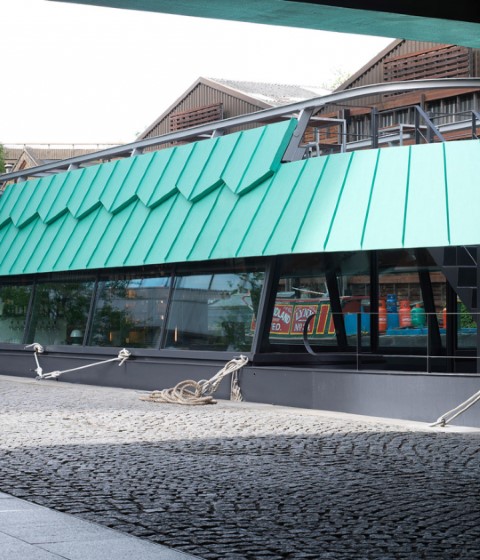The kitchen elements on the other hand adopt a technical aesthetic, using stainless steel as a sanitary surface on which to prepare or serve meals. The false ceiling leaves the kitchen invading the rest of the space with metallic reflections, blurring the difference between the two sides of the bar.
Description of project by BURR
Brutal Burrito takes the temporary, sporadic spaces that appear on any corner to offer you a product or a service as a referential approach: an informal market stand, vending spots or street food trolleys.
The idea is to capture that feeling of spontaneity and reversibility in accordance with the gastronomic project itself, both for its condition close to street food and for its ambition to change and evolve.
The project treats the space as a body to be clothed, therefore establishing a distinction between naked and dressed parts. The pre-existing space remains undressed, assuming a raw aesthetic based on rough plastered surfaces and floors that reflect the materiality of the surrounding sidewalks.
On the other hand, a textile system distributes the dining areas. A model that allows the space to be dressed up on special occasions, to put on a costume on a celebration, or to wear working clothes on a daily basis. A pattern model rather than a closed design.
This elements are based on techniques used in street markets or similar events: stretched fabrics to separate spaces, often made of plastic to repel water and matt to protect from the sun. Flat coloured tarpaulins; reused, branded surfaces or specifically designed textiles for an event could be set up to transform the space on a particular occasion.
To create a contrast with this street-like reference, the project leans on rather classical influences using arcades to delimit the interior spaces. This kind of structure resembles inflatable castles for children; a kind of plastic-made tradition.
This dismountable, almost disposable condition gives the space a certain spontaneity; the feeling of being a place that does not really belong there. In line with this idea, the facade display consists of intentionally mismatched elements, making the arcades appear unrelated to the large street-windows, so that it is understood as a series of layers that don't fit each other.
The kitchen elements, on the other hand, take a fixed position. They adopt a functional, technical aesthetic, using stainless steel as a sanitary surface on which to prepare or serve food. The ceiling extends out of the kitchen, invading the rest of the space with metallic reflections, blurring the difference between the two sides of the bar counter.
Among all the kitchen elements, two stand out above all others. The first one is the comal, an adaptation of the traditional pre-Columbian cookware mainly used in Mexico.
It takes a central position, both physically and symbolically, representing all cooking operations developed by Brutal Burrito. It is a shiny stainless steel cylinder, split in two halves, a griddle and an exhaust hood, only connected by smoke and flames.
The second element is the tortilladora, an appliance specifically developed to produce tortillas, rarely found outside of Latin America. The visitor encounters the tortilladora in action, producing the tortillas that will later be eaten, enclosed in a protective glass case.
The furniture designed for Brutal Burrito is based on the aluminum tube bending technique, essentially used for the production of outdoor furniture for small bars and restaurants in Spain.
A simple system of several bends per tube to generate double legs for both the tables and the high stools. For the tabletops and seats the chosen material is a high-density cutting board, commonly used in the kitchen for chopping and slicing food. The repetition of these elements results in two large shared-use tables.
3TG's graphic identity project is expressed in LED screens around the restaurant that pick up and emphasize this feeling of a temporary funfair, launching messages and promotions related to the products they offer.
























































